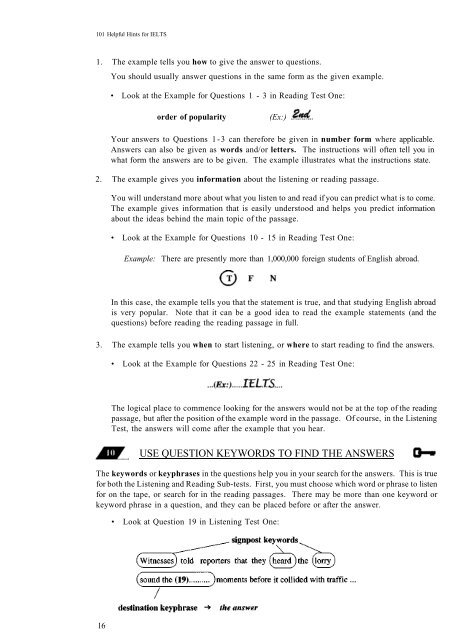You also want an ePaper? Increase the reach of your titles
YUMPU automatically turns print PDFs into web optimized ePapers that Google loves.
101 Helpful <strong>Hints</strong> <strong>for</strong> <strong>IELTS</strong><br />
1. The example tells you how to give the answer to questions.<br />
You should usually answer questions in the same <strong>for</strong>m as the given example.<br />
• Look at the Example <strong>for</strong> Questions 1 - 3 in Reading Test One:<br />
order of popularity<br />
(Ex:)<br />
Your answers to Questions 1-3 can there<strong>for</strong>e be given in number <strong>for</strong>m where applicable.<br />
Answers can also be given as words and/or letters. The instructions will often tell you in<br />
what <strong>for</strong>m the answers are to be given. The example illustrates what the instructions state.<br />
2. The example gives you in<strong>for</strong>mation about the listening or reading passage.<br />
You will understand more about what you listen to and read if you can predict what is to come.<br />
The example gives in<strong>for</strong>mation that is easily understood and helps you predict in<strong>for</strong>mation<br />
about the ideas behind the main topic of the passage.<br />
• Look at the Example <strong>for</strong> Questions 10 - 15 in Reading Test One:<br />
Example: There are presently more than 1,000,000 <strong>for</strong>eign students of English abroad.<br />
In this case, the example tells you that the statement is true, and that studying English abroad<br />
is very popular. Note that it can be a good idea to read the example statements (and the<br />
questions) be<strong>for</strong>e reading the reading passage in full.<br />
3. The example tells you when to start listening, or where to start reading to find the answers.<br />
• Look at the Example <strong>for</strong> Questions 22 - 25 in Reading Test One:<br />
The logical place to commence looking <strong>for</strong> the answers would not be at the top of the reading<br />
passage, but after the position of the example word in the passage. Of course, in the Listening<br />
Test, the answers will come after the example that you hear.<br />
USE QUESTION KEYWORDS TO FIND THE ANSWERS<br />
The keywords or keyphrases in the questions help you in your search <strong>for</strong> the answers. This is true<br />
<strong>for</strong> both the Listening and Reading Sub-tests. First, you must choose which word or phrase to listen<br />
<strong>for</strong> on the tape, or search <strong>for</strong> in the reading passages. There may be more than one keyword or<br />
keyword phrase in a question, and they can be placed be<strong>for</strong>e or after the answer.<br />
• Look at Question 19 in Listening Test One:<br />
16




